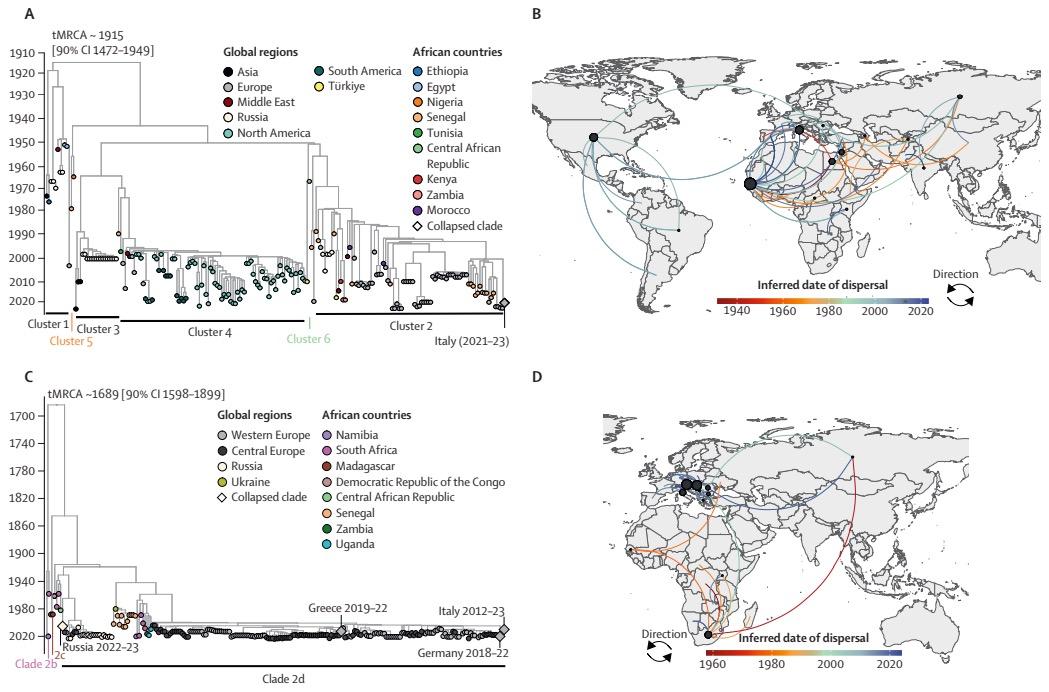
3 minute read
GENOMIC SURVEILLANCE GAPS IN AFRICA FOR WEST NILE VIRUS
Publication at the Lancet Microbe Moir et al. 2025
Open Access: Scan the QRCode to access the publication figure: Monika Moir
West Nile virus (WNV), a high-priority pathogen endemic to Africa, has limited genomic data available despite widespread detection. This review reveals major gaps in molecular surveillance and the urgent need for a One Health approach in disease surveillance.
Summary
West Nile virus (WNV) is a priority pathogen that poses a high risk for public health emergencies of global concern. Although WNV is endemic to Africa, only few (n=63) whole genomic sequences are available from the continent. In this review, we examined the status of the molecular testing and genomic sequencing of WNV across Africa and mapped its global spatiotemporal spread. WNV has been detected in 39 African countries, the Canary Islands, and Réunion Island. Although publications, including those with molecular data, originated from 24 of these countries, genomic sequences were available from only 16 countries. Our analysis identified regions with detected viral circulation but without molecular surveillance.
The current literature has substantial knowledge gaps in terms of the disease burden, molecular epidemiology, and distribution of WNV in Africa. Addressing these gaps requires an integrated One Health surveillance approach, which is challenging to establish. We propose three key surveillance needs that could improve the current understanding of the WNV disease burden in Africa, to strengthen the global public health response to this vector-borne disease.
Discussion of the Findings
Although WNV is a priority pathogen of international concern, our analysis identified key knowledge gaps in the true burden of disease, molecular epidemiology, and distribution of WNV in Africa. We found evidence of viral circulation in 39 of the 55 African countries. Molecular data for WNV are available from 24 of these countries, but most of them have insufficient data for all hosts and vectors. Only 63 genomic sequences from 16 African countries are available publicly. For some countries, evidence of WNV circulation is solely based on studies that used serological methods, as there are no existing molecular data.
Serological cross-reactivity among flaviviruses and cocirculation of multiple antigenically related flaviviruses in Africa might have resulted in an overestimation of the true extent of WNV circulation in these countries. The use of virus neutralisation tests to confirm IgM and IgG serology is important to accurately assess the incidence of cases and seroprevalence.
Our findings show that Africa is the origin of internationally important WNV lineages. However, despite early epidemics in Uganda, Sudan, the Democratic Republic of the Congo, and Kenya (as far back as 1939), research efforts have largely focused on the virus’s spread in North America and Europe, with comparatively little work conducted in Africa. Here, we discuss three key challenges, which are aligned with WHO’s technical brief on research prioritisation for pandemic and epidemic intelligence.
Conclusion
The burden of WNV (in addition to that of other arboviruses) remains under-recognised in Africa, with fragmented data and weak surveillance. Clinical and genomic surveillance for WNV are inadequate, hindering public health responses and obscuring the true disease burden.
Open Access Publication
Identifying genomic surveillance gaps in Africa for the global public health response to West Nile virus: a systematic review. Monika Moir and Colleagues. The Lancet Microbe, 2025. https://www.thelancet.com/ journals/lanmic/article/ PIIS2666-5247(25)00104-1/fulltext











